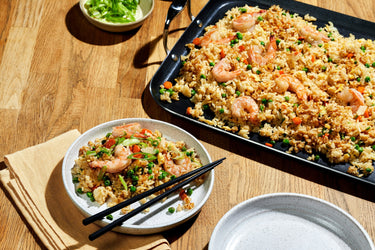A guide to short-grain vs. medium-grain vs. long-grain rice

There are a lot of reasons why you might be wondering what the right kind of rice is to use in a recipe. Perhaps you’re getting ready to do your weekly meal prep and you’ve selected a paella and are wondering what the hell bomba rice is. Perhaps you loved a luxurious risotto on a trip to Rome and want to recreate it. Or, you might have discovered a bag or two of random rice varieties tucked away in the back of your cabinet while resetting your pantry and want to use them up. This gluten-free staple can be used in endless dishes from breakfast to lunch to dinner.
With rice, the distinctions come down to starch content and length. You’ll want to stick to the kind of rice called for in a recipe as it will affect cooking time and texture.
A GUIDE TO VARIETIES OF RICE AND IDEAS FOR HOW TO COOK THEM
There are three different lengths of rice that come in different varieties. You may find a recipe that calls for short-grain rice, medium-grain rice, or long-grain rice without specifying a specific type (e.g. bomba rice, which is a short-grain rice used for paella).
Short-grain rice
Short-grain rice is small and squat and has a toothsome texture. It comes in white and brown varieties and has a starchier texture than other types of rice. This makes short-grain rice good for dishes like rice pudding, risotto, or sushi. Brown short-grain rice cooks up nicely for pilafs, grain bowls, and rice salads. Commonly used varieties of short-grain rice include short-grain brown rice or glutinous (aka sticky) rice for dishes like sticky rice with mango. For sushi rice, you are likely to find both short-grain and long-grain Japonica varieties. If you want a stickier outcome, choose short-grain, which makes the rice easier to eat with chopsticks or form into sushi.
Opinions differ on whether Arborio rice for Italian dishes like risotto or bomba and Calasparra rice to make the Spanish dish paella are short-grain or medium-grain. Rather than fuss over the details, instead just stick to the traditional varieties for each dish and you can’t go wrong.
Want to get started with short-grain rice? Try this recipe for Sheet-Pan Turmeric Chicken and Crispy Rice from NYTimes Cooking or Khao Niao (Thai Sticky Rice) Recipe from Serious Eats. Or, use short-grain rice to make our recipe for Hibachi-Style Shrimp Fried Rice.
Medium-grain rice
As might be expected, medium-grain rice varieties fall somewhere between short- and long-grain. It has more starch than long-grain rice but clumps together less than short-grain (though once it cools, it does become a bit stickier). As mentioned above, some sources consider Arborio rice for risotto and bomba rice for paella medium-grain rather than short-grain. If you’re cooking one of these traditional dishes, make sure to buy the specific variety. Black rice is a medium-grained rice variety that originated in China that has a gorgeous, dark hue thanks to an abundance of anthocyanins. Jasmine rice is medium-grain and can be found in white, brown, and red varieties. Traditionally served with Thai food, jasmine rice is deeply fragrant.
Use medium-grain rice like Carolina gold or Arborio to make Nixta Taqueria’s Sholeh Zard.
Long-grain rice
You’re likely to see many varieties of long-grain rice at the store. Basmati hails from northern India and Pakistan. The beautifully fragrant grains are toothsome and can be found in brown and white varieties. Serve basmati rice alongside curries, as part of a biryani, or as part of a rice salad or pilaf. Basmati rice is commonly used in Middle Eastern dishes like saffron rice or tahchin.
You’ll want to use long-grain basmati rice to make the stunning Persian chicken and rice dish Tahchin, which is perfect made in your 5-quart Hybrid Dutch Oven. Or, make white basmati rice to serve with Okra and Shrimp Coconut Curry.
What about wild rice?
Wild rice is not rice but a seed from a type of grass but is called such because it’s eaten as rice or mixed into a blend. Enjoy it mixed into a pilaf, as part of a rice salad, or stuffed into roasted butternut squash.





